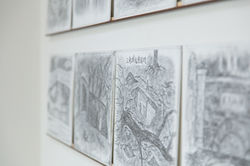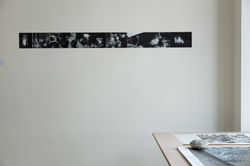 |  |  |  |
|---|---|---|---|
 |  |
2019 臺南新藝獎 NEXT ART TAINAN
Award Winner 黃彥勳 HUANG Yen-Hsun
Invited Artist 高俊宏 KAO Jun-Honn
Curator 陳明惠 Ming Turner
14 Mar. - 14 Dec. 2019
《2019臺南新藝獎》以「[不]可見的維度」為名,期待以當代藝術的多樣貌,再現當今生活中可見與不可見的地景或人文氛圍。本展覽不僅以藝術的手法重新詮釋,並再現我們日常生活中可見的三維度空間裡的人事物,並以藝術家的想像與對於生命的體悟,呈現那一層不可見,且代表時間、人文、哲學之抽象維度,也就是超維度空間。《2019臺南新藝獎》以扶持新生代藝術家為主旨,並特別邀請中生代與前輩藝術家與這些徵選出來的新生代藝術家一起展出,期待作品可以對話並相輔相成。展出作品議題涉及具體可辨識、抽象具哲思的不同面相,包含:城市街景的繁華、歷史景物及其文化意涵、性別的曖昧、廢墟之惆悵感、居住議題、市井文化之戲劇性、機車文化與年輕世代之不確定性等。
本展覽集結二十位來自臺灣、英國、挪威,跨不同世代與文化背景的當代藝術家,一起在臺南共十個藝術空間展出,展現藝術家對於可見的生活景象、人誌、地誌之再現、拼組與解構,更對於那確實存在但又不可見的生命感,及對於社會與人文現象的批判與反思,作品透過繪畫、複合媒材、新媒體、陶藝、雕塑、攝影、電腦繪圖等不同創作形式來重新詮釋。《2019臺南新藝獎》不僅呈現國內優秀不同世代藝術家之作品,更透過國外藝術家在臺南之現地創作,期待臺南藝術界更具當代且國際的視野與風格,及呈現臺南這城市在當代藝術的意識型態上之多樣性與敏銳度。
2019Next Art Tainan
Invisible Dimensions
The title of the 2019 Next Art Tainan exhibition is ‘Invisible Dimensions’, which aims to represent the diversity of contemporary art, and both the visible and the invisible landscape and culture. The exhibition visualizes three dimensional people and objects, and through the artists’ imagination and their reinterpretation of life, the work also visualizes the invisible trans-dimensions of our everyday life, such as the abstract concepts of time, humanity and philosophy.2019 Next Art Tainan aims to support emerging and talented young artists by inviting specially selected established artists to exhibit their work alongside theirs, as a result of which the art will have a dialogue and will respond to each other. The themes of the exhibited work cover both recognizable and conceptual aspects of our surroundings, including the prosperity of our urban landscape, historical artifacts and their cultural connotations, the ambiguities of gender, the melancholy of abandoned relics, discourses pertaining to housing, the dramatic effect of grassroots culture, scooter culture and the uncertainties being faced by the younger generations.
The exhibition features ten groups of artists from Taiwan, the UK and Norway, from a diverse range of generations and cultural backgrounds, who will exhibit their works in ten different galleries across Tainan. The project features a representation, construction and deconstruction of the visible living environment and its people, as well as challenging and re-considering the exiting, yet invisible, dimensions of life, society and culture. The exhibited works include paintings, multi-media, new media, ceramics, sculpture, photography, and computer-generated images, among others. 2019 Next Art Tainan presents a range of excellent artworks created by artists of different generations, and furthermore, by inviting international artists to create site-specific work in Taiwan, the project expects to embrace more contemporary and international visions and ambitions, and thereby draw attention to the senses of contemporaneity, diversity and sensitivity in art in Tainan city.
關於藝術家 ▍
黃彥勳 Yen-Hsun Huang
1994年出生於臺灣新北市,國立臺灣藝術大學美術學系畢業,目前就讀國立臺灣藝術大學美術學系碩士。2016年曾獲得大墩美展油畫首獎、2017與2018年連兩年獲桃源美展油畫類首獎,也曾入選桃源創作獎、臺中港區新貌獎、全國美展及鴻梅新人獎等獎項。創作主要為壓克力平面繪畫,亦多方嘗試複合媒材裝置、影像等創作形式。在創作題材上圍繞著生命的探索與追尋永恆、未來末世等大主題進行思考,對人類的渺小之軀之於宙海蒼茫的無力感到悲觀,但同時人們又積極追逐未知的真理與無窮的秘密,探索、尋找意義,理解認識,建造紀念碑留予傳唱,傳承人類所理解的宇宙解答,並繼續追求永恆。
Yen-hsun Huang was born in New Taipei City, Taiwan, in 1994. He graduated from the National Taiwan University of Arts, and is currently continuing his studies for a master’s degree in fine arts. In 2016, he won first prize in the oil painting category of the Da Dun Fine Arts Exhibition, and in 2017 and 2018 he won first prize in the oil painting category of the Taoyuan Fine Arts Exhibition. He also won the Taoyuan Contemporary Art Awards, Taiwan Emerging Art Awards, National Art Exhibition, and Grand View Emerging Art Awards. His creations are mainly achieved through acrylic painting, and he also creates various forms of installation and video art. In the process of his creations, he is surrounded by major narratives, such as human exploration and the pursuit of eternity. In the case of his artistic concepts, he thinks that humans often feel powerless and pessimistic, and at the same time, people actively chase unknown secrets and truths, exploring meaning and building monuments for future generations, as well as inheriting a human understanding of the universe, and continuing to pursue the eternal.
高俊宏Jun-Honn Kao
高俊宏的創作模式以計畫性藝術以及寫作為主,目前創作、生活於臺北。他的研究是以當代社會為基礎,透過錄像、身體與書寫等形式探討空間、政治、記憶與歷史問題。他畢業於臺南藝術大學藝術創作理論研究所博士班,現為臺北藝術大學兼任助理教授,過去曾為東亞藝術佔領計畫研究主持人,現亦為原住民議題紀錄片導演。
他自1995年起曾舉辦過多次個展,也曾在香港、英國、法國等地駐村。著作《群島藝術三面鏡》(包含「小說:台籍日本兵張正光與我」、「諸眾:東亞藝術佔領行動」、「陀螺:創作與讓生」等三本書)曾獲2016年金鼎獎非文學類獎以及年度最佳圖書獎。他的近期藝術實踐包括東亞藝術行動研究、「廢墟影像晶體計畫」、關於衛星城市地帶記憶的錄像「博愛」、非虛構寫作:「橫斷記:台灣山林戰爭、帝國與影像」,以及正在進行中,結合紀錄影像、寫作與當代藝術的「大豹」計畫。高俊宏目前研究的議題以諸眾、空間、生命政治、歷史與原住民為主,除了影像與書寫之外,他亦透過長期的田野經驗,涉及了更複雜的社會經濟層面議題。
Jun-honn Kao is an artist and writer who lives and works in Taipei, Taiwan. His research-based works focus mainly on contemporary society in Taiwan, engaging space, politics, memories, and histories in the form of video art, physical practice, and writing. He graduated from Tainan National University of the Arta with a PhD in Art Creation. He is currently an Adjunct Assistant Professor at Taipei National University of Arts. He was the project director of East Asia Multitude Meeting 2013: Post-Occupy (art /activism) Study, and has worked as a documentary director exploring issues concerning the indigenous people of Taiwan.
Since 1995, he has held several solo exhibitions in Taiwan and abroad, and has been an artist in residence in Hong Kong, England, and France, among other locations. In recent years, his artistic practice has included the investigation of East Asian art activists, ‘The Ruin Image Crystal Project’, the documentary project of ’Bo Ai’ in the satellite towns and townships in northern Taiwan, the ‘Traversing Archives: Taiwan’s Mountain War, Empire and Image’ on the development of modern Taiwan’s forests, and an ongoing project regarding the indigenous people of Taiwan, known as the ‘Topa Project’. Jun-honn Kao’s current research focuses on issues surrounding history and the multitudes, space, and indigenous and bio-politics. He uses documentary film as one of his main forms of artistic practice, and undertakes in-depth fieldwork for his studies, placing his findings within complex socio-economic contexts.
